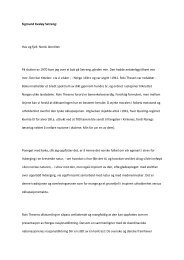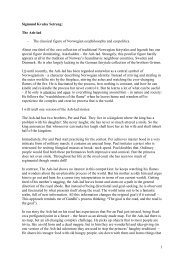The Healing Power of Nature - Norwegian Journal of Friluftsliv
The Healing Power of Nature - Norwegian Journal of Friluftsliv
The Healing Power of Nature - Norwegian Journal of Friluftsliv
You also want an ePaper? Increase the reach of your titles
YUMPU automatically turns print PDFs into web optimized ePapers that Google loves.
animals, and minerals in non material doses cured the symptoms in ill people while these same<br />
substances <strong>of</strong>ten would cause ill symptoms in healthy people. Hanhnemann, followed by others,<br />
developed over 3500 remedies. While homeopathy has struggled with the American Medical<br />
Association (AMA) in the US, it has been practiced beside allopathic medicine in many countries and is<br />
seeing a revival since the late twentieth century in the US.<br />
Dating back to the 1800s romantic notions about nature <strong>of</strong>ten fueled getting outside in the US,<br />
when it was not for work. Frequently these romantic notions were about being refreshed by spending<br />
time in nature, akin to the current restoration theories. John Muir’s writings speak to this concept:<br />
“Climb the mountains and get their good tidings, nature’s peace will flow into you as the sunshine into<br />
the trees. <strong>The</strong> winds will blow their freshness into you, and the storms their energy, while cares will<br />
drop <strong>of</strong>f like autumn leaves.” This time period saw Henrik Ibsen’s writing about friluftsliv which <strong>of</strong> course<br />
has become a unifying concept for outdoor enthusiasts and educators in the Scandinavian countries.<br />
<strong>The</strong> concept <strong>of</strong> a vacation (a time away for rest) in Europe was most likely a result <strong>of</strong> the influences<br />
<strong>of</strong> industrialization and urbanization combined with a wish for the romantic. In the early 1800s the<br />
concept <strong>of</strong> going to the mountains for health was becoming in vogue. For example an English woman,<br />
Isabella Bird Bishop (1831 – 1904) travelled at the advice <strong>of</strong> her physician. When she was at home in<br />
Britain she <strong>of</strong>ten was ill with the vapors and other nondescript ailments. When she travelled in Canada,<br />
Scotland, and the Rocky Mountains in the US while pursing her natural history interests in nature she<br />
was not ill. By the 1820s mountaineering and adventure pursuits were ensconced in Europe and by the<br />
1930s the British Mountaineering Leadership Scheme was developed. This beginning <strong>of</strong> exploration and<br />
adventure excursions formed the basis for adventure travel, and challenge courses programs in<br />
Australia, Canada, Great Britain, New Zealand and the US (Priest, 1986). <strong>The</strong> concept <strong>of</strong> vacationing for<br />
health and renewal has been maintained better in Europe, New Zealand, and Australia where six weeks<br />
13




